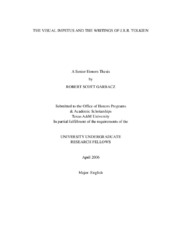| dc.description.abstract | Visual illustrations were critical to Tolkien's creativity—they preceded his creation of lexical texts, helped to define the world in which he set most of his literature, and continued to hold a great significance in the publication of Tolkien's texts. Yet the one essay Tolkien wrote in an attempt to bridge the gap between his career as a Medieval philologist and his hobby of creating fantasy stories, “On Fairy-stories”, actively condemned the illustrations that Tolkien was then creating. “In human art, Fantasy is a thing best left to words,” (Tolkien, Reader 70) and even when art is set in support of words, “illustrations do little good to fairy-stories.” (Tolkien, Reader 95) While Tolkien offers a small number of theoretical arguments against fantasy illustrations in “On Fairy-stories,” it is my assertion that such an opinion represents Tolkien's particular personal and historical position rather than an authoritative understanding of the nature of his own art.
In my undergraduate honors thesis, I am proposing an alternative to Tolkien's conclusion about the value of his illustrations by showing that Tolkien's illustrations served a critical role in the formation of his literary creations of fantasy. My methodology is to combine a chronologically disciplined close reading of his illustrations with a brief overview of those of Tolkien's writings that intersect with his interest in illustration. I trace the evolution of Tolkien's visual work through: (1) childhood creation of realistic illustrations in which Tolkien developed his ability to comment upon the world; (2) early fantasy illustrations, which predated Tolkien’s fantasy texts but themselves present one-image visual “stories” with philosophical implications and openness similar to his later fantasy texts; (3) illustrations for Tolkien’s “legendary history,” in which he created a geography of emotional landscapes through which he could move the characters of his fantasy texts; and (4) illustrations for children’s stories, in which Tolkien reintroduced the humor, character, and satire from his childhood illustrations to his fantasy fiction. I not only argue that illustrations are a significant companion to Tolkien's lexical texts, but also that they provide another perspective on the study of illustrations. | en |


